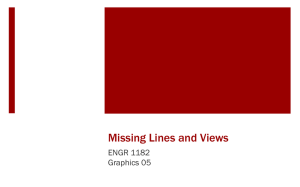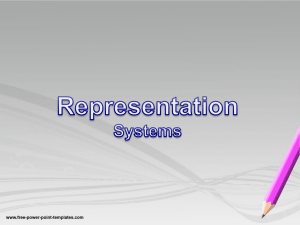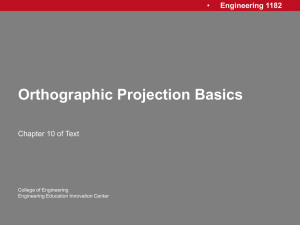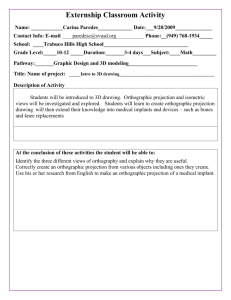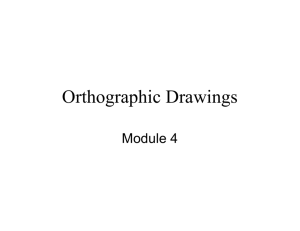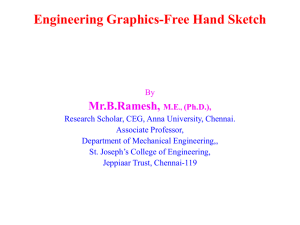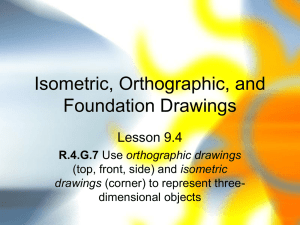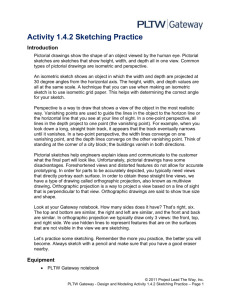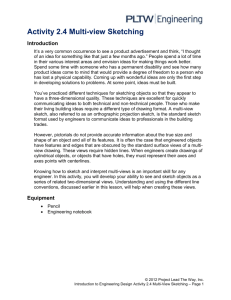Engineering sketching / Microsoft Office PowerPoint 97
advertisement
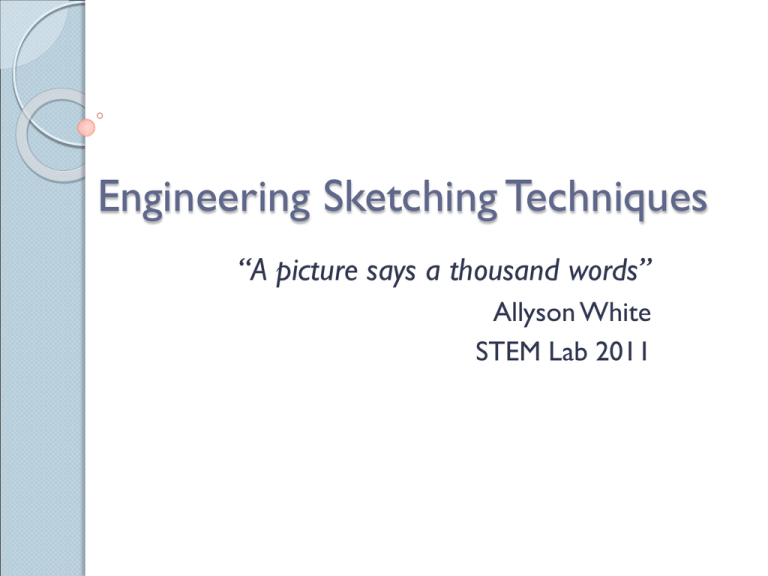
Engineering Sketching Techniques “A picture says a thousand words” Allyson White STEM Lab 2011 THE DESIGN PROCESS Define Goals Generate Ideas Plan Improve Test Build Learning Goals Recognize the three basic styles of engineering sketches. Understand why a detailed sketch is a powerful communication tool. Be able to accurately sketch an object using isometric, orthographic, and oblique design methods. Why? Troubleshooting: ◦ Sketches allow engineers to see each part of a product before a prototype is developed Communication: ◦ Sketches reveal details of a product; size shape, and features, quickly and accurately. 5 Minutes to Prove It! This activity will illustrate how much better a sketch communicates an idea than a verbal description. 1. Draw a large rectangle on your paper. 2. Draw 2 smaller rectangles inside the large rectangle. 3. Draw a circle inside one of the small rectangles. 4. Compare your design to your neighbors. Are all the designs the same? Does your design match mine? Isometric Projection Isometric projections show three sides of an item in proportional dimensions. ◦ All vertical lines are vertical ◦ All horizontal lines are drawn at a 30° angle. Picture Source: Total Fabrication, Retrieved from: http://tle.tafevc.com.au/toolbox/items/2915349d-458b-d355-6733a2388c8eb190/1/905_draw_t3.zip/2_draw/draw_t3/htm/draw3_2_2.htm Isometric Projection- Dimensions Clearly label important dimensions. Label contains numbers only Unit of measurement is located bottom of design Do not label more than is necessary to build the item. Illustration created with Google SketchUp 6® Orthographic Projection Orthographic sketches represent 3D items in multiple 2D drawings. Top, front, bottom, and side views may be used. The general rule is to use only the views necessary to show the details of the item. The Glass Box Imagining your item in a glass box is a good way to mentally separate the faces of the item before beginning an orthographic sketch. Image source: Martin (n.d.) https://mail.nvnet.org/~martins/TAD1/linx/ortho.html Orthographic Example Top Side left The edges of each view line up as though “the box” had been unfolded. Illustration created with Google SketchUp 6® Oblique Projection Oblique projections are 1. perhaps the simplest of the 3D sketch techniques. 1. Sketch the front of the item. 2. Project lines back from the vertices at 45° angles. These lines are drawn at one-half scale. 3. Connect the lines to form the visible portion of the back of the item. Computer Aided Design (CAD) Software packages range from the simple such as the ModelSmart program we use, Google SketchUp (free to download) to the very complex. Manual Design There are many specialized tools for manually creating technical designs. ◦ ◦ ◦ ◦ ◦ ◦ ◦ ◦ 45°/90° triangle 30°/60° triangle Protractor Square Ruler Compass Specialized grid paper And many more... Independent Practice Choose a common object that is easily identified. Create 3 projections of the object. ◦ Isometric ◦ Orthographic ◦ Oblique Use the classroom drafting tools. Use the specialized grid paper. Drafting tools may be signed out during pm homeroom and must be returned during the next morning’s am homeroom Resources for Students Sokolowski, G. (2004) Orthographic Projection #1, Wisc-Online. http://www.wisc-online.com/objects/ViewObject.aspx?ID=ENG19204 Ryan,V. (2011) Oblique projections: http://www.technologystudent.com/despro2/obli1.htm Ryan,V. (2011) Isometric projections: http://www.technologystudent.com/prddes1/drawtec2.html Standards Alignment Standard 11: Students will develop abilities to apply the design process. ◦ [H] Apply a design process to solve problems in and beyond the laboratory-classroom. ◦ [J] Make two-dimensional and three-dimensional representations of the designed solution. Standard 17: Students will develop an understanding of and be able to select and use information and communication technologies. ◦ [K] The use of symbols, measurements, and drawings promotes clear communication by providing a common language to express ideas. Resources EST Foundations (2006), Topic 3- Engineering Sketching. Retrieved from: http://www.estfoundations.com/index.html Google Inc., (2007) Google SketchUp Version 6.4.112. Retrieved from: http://sketchup.google.com/ Martin Suzette (n.d.) Technical and architectural design one, Orthographic projection. Retrieved from: https://mail.nvnet.org/~martins/TAD1/linx/ortho.html Ryan,V. (2011) Isometric projections: technologystudent.com. Retrieved from: http://www.technologystudent.com/prddes1/drawtec2.html Ryan,V. (2011) Oblique projections:, technologystudent.com. Retrieved from: http://www.technologystudent.com/despro2/obli1.htm Sokolowski, G. (2004) Orthographic Projection #1, Wisc-Online. Retrieved from: http://www.wisc-online.com/objects/ViewObject.aspx?ID=ENG19204 Total Fabrication, (n.d.) What is isometric drawing?. Retrieved from: http://tle.tafevc.com.au/toolbox/items/2915349d-458b-d355-6733a2388c8eb190/1/905_draw_t3.zip/2_draw/draw_t3/htm/draw3_2_2.htm

